
Background
Wageningen University and Research (WUR), the Climate Food and Farming – Global Research Alliance Development Scholarships (CLIFF-GRADS) research fellows, the CGIAR Research Program on Climate Change, Agriculture and Food Security (CCAFS), and the restaurant at Ayana Resort worked together to present conference participants with climate-smart lunches. Given the transformational goals of the 5th Global Science Conference on Climate-Smart Agriculture, we raised awareness of the impact of diet choices and of food loss and waste on our carbon footprint and progressively and collectively decrease the carbon footprint of our lunches. Through menus that shift from a traditional conference buffet to a healthy, sustainable reference diet to a healthy, sustainable vegan diet (with meat substitutes), and through an experiment that will measure participants’ total food waste, we empowered participants with knowledge needed for food systems transformation under climate change.
Combining specific data from the hotel regarding ingredients and their sources and food preparation techniques with global data sets regarding food production, food loss, and food waste, we used a new calculator developed at WUR to estimate the carbon footprint of the food served at the conference.
During the lunches at the conference, CLIFF-GRADS fellows shared messages that pertain to the emissions footprint of food production, food losses in supply chains, the impact of individual food choices, and food waste.
Lunches were a great time to enjoy excellent meals and learn!
How did we get to these results? Guidelines for students to calculate the emissions:
- Formulate ingredient list
- Calculate weight fraction per ingredient as part of the total ingredients
- Choose comparable crop category from the list in the Agro Chain Greenhouse Gas Emissions (ACGE) calculator (unless no suitable is available)
- For those ingredients that no suitable crop category is available, try to find GHG emission factor from literature
- Write down the GHG emission factor (kg CO2-eq. per kg product) for the product according to the cited literature
- Estimate typical transportation distance truck and ship (except for literature-sourced data)
- Use ACGE calculator: calculate total GHG emission "per kg sold in retail" for the product category:
- choose crop, fill in appropriate truck transport distance, fill in appropriate ship transport distance
- Calculate the results
Diving into the data: calculations for the meals
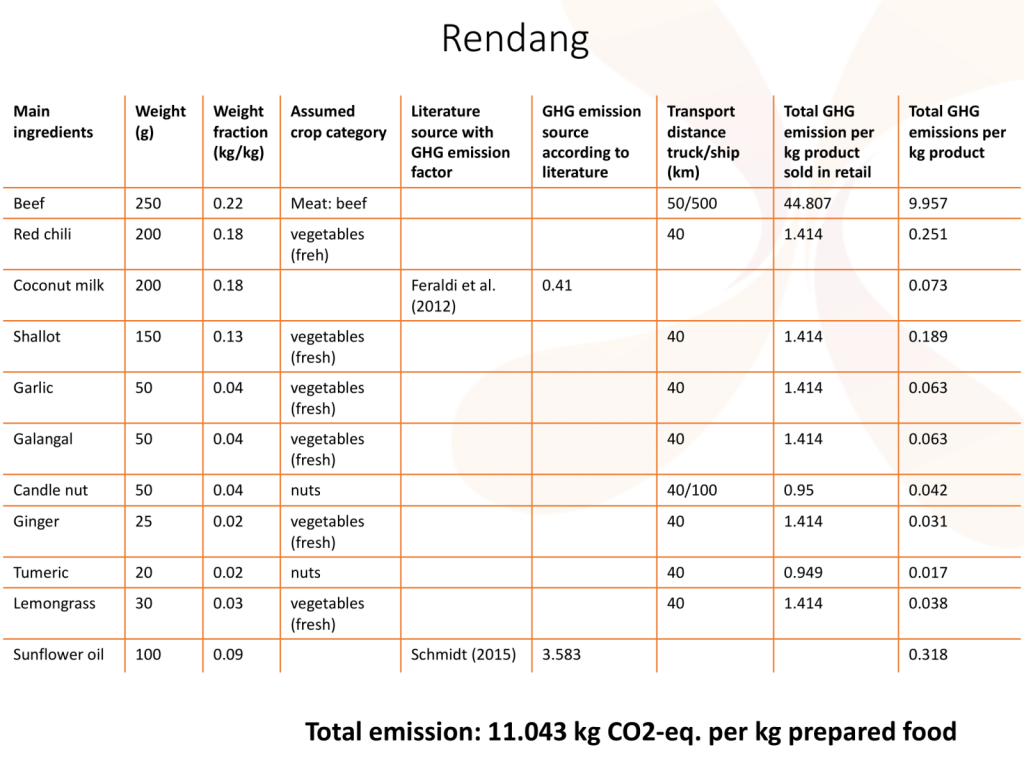
Remarks:
For spices and herbs no (or little?) literture on GHG emission factors is available; assume it's in the category of nuts.
GHG emission factors for vegetable oils (Schmidt, 2015):
- Palm oil: 4.847 kg CO2-eq. per kg oil
- Rapeseed oil: 3.085 kg CO2-eq. per kg oil
- Sunflower oil: 3.583 kg CO2-eq. per kg oil
- Peanut oil: 7.541 kg CO2-eq. per kg oil
Literature:
Feraldi, R., M. Huff, A. M. Molen and H. New (2012). Life Cycle Assessment of Coconut Milk and Two Non-Dairy Milk Beverage Alternatives. LCA XII. Tacoma, American Center for Life Cycle Assessment 23.
Schmidt, J.H. (2015): Life cycle assessment of five vegetable oils, Journal of Cleaner Production, Vol. 87, pp. 130-138.
Calculations were done by Xia Liang, CLIFF-GRADS fellow.

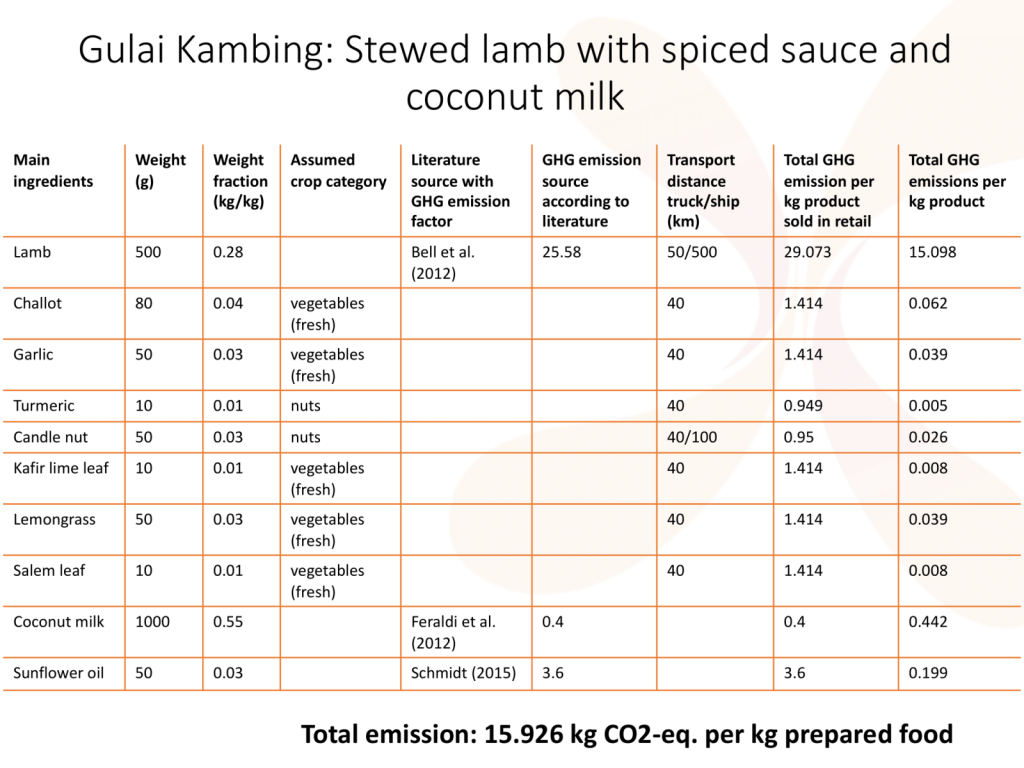
Remarks:
For spices and herbs no (or little?) literture on GHG emission factors is available; assume it's in the category of nuts.
Literature:
- Feraldi, R., M. Huff, A. M. Molen and H. New (2012). Life Cycle Assessment of Coconut Milk and Two Non-Dairy Milk Beverage Alternatives. LCA XII. Tacoma, American Center for Life Cycle Assessment 23.
- Schmidt, J.H. (2015): Life cycle assessment of five vegetable oils, Journal of Cleaner Production, Vol. 87, pp. 130-138.
Calculations were done by Jan Broeze, CCAFS Food Loss and Waste project leader

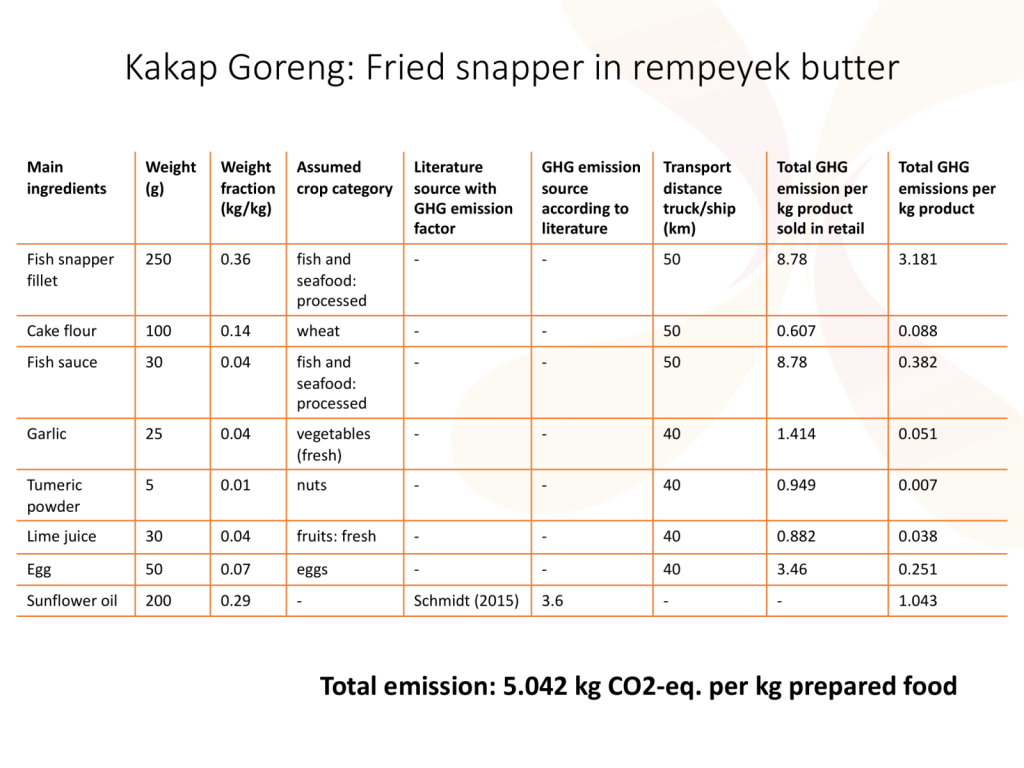
Remarks:
- According to the literature found, most of the wheat used in Indonesia comes from Australia.
- Not sure which category is best suited for fish souce (no literature found).
Literature:
Schmidt, J.H. (2015): Life cycle assessment of five vegetable oils, Journal of Cleaner Production, Vol. 87, pp. 130-138.
Calculations were done by Daniele Matzembacher, CLIFF-GRADS fellow.


Remarks:
For spices and herbs no (or little?) literture on GHG emission factors is available; assume it's in the category of nuts.
GHG emission factors for vegetable oils (Schmidt, 2015):
- Palm oil: 4.847 kg CO2-eq. per kg oil
- Rapeseed oil: 3.085 kg CO2-eq. per kg oil
- Sunflower oil: 3.583 kg CO2-eq. per kg oil
- Peanut oil: 7.541 kg CO2-eq. per kg oil
Literature:
Feraldi, R., M. Huff, A. M. Molen and H. New (2012). Life Cycle Assessment of Coconut Milk and Two Non-Dairy Milk Beverage Alternatives. LCA XII. Tacoma, American Center for Life Cycle Assessment 23.
MacLeod, M., Gerber, P., Mottet, A., Tempio, G., Falcucci, A., Opio, C., Vellinga, T., Henderson, B. & Steinfeld, H. 2013. Greenhouse gas emissions from pig and chicken supply chains – A global life cycle assessment. Food and Agriculture Organization of the United Nations (FAO), Rome.
Calculations were done by Tabitha Nindi, CLIFF-GRADS fellow.


Remarks:
- Truck as the only transportation method was assumed.
- GHG emission factors for vegetable oils (Schmidt, 2015): 3.583 kg CO2-eq. per kg oil
- GHG emission factors for coconut milk (Feraldi et al., 2012): 0.4 kg CO2-eq. per kg oil
- Coconut milk density: 1.02 gr/ml
- Sweet soya sauce density: 1.35 gr/ml
- Sunflower oil density: 0.95 gr/ml
Literature:
- Feraldi, R., M. Huff, A. M. Molen and H. New (2012). Life Cycle Assessment of Coconut Milk and Two Non-Dairy Milk Beverage Alternatives. LCA XII. Tacoma, American Center for Life Cycle Assessment 23.
- Schmidt, J.H. (2015): Life cycle assessment of five vegetable oils, Journal of Cleaner Production, Vol. 87, pp. 130-138.
- Emission Factors for Greenhouse Gas Inventories
Calculations were done by Li Xue, CLIFF-GRADS fellow.


Remarks:
For spices and herbs no (or little?) literture on GHG emission factors is available; assume it's in the category of nuts.
GHG emission factors for vegetable oils (Schmidt, 2015):
- Palm oil: 4.847 kg CO2-eq. per kg oil
- Rapeseed oil: 3.085 kg CO2-eq. per kg oil
- Sunflower oil: 3.583 kg CO2-eq. per kg oil
- Peanut oil: 7.541 kg CO2-eq. per kg oil
Literature:
- Feraldi, R., M. Huff, A. M. Molen and H. New (2012). Life Cycle Assessment of Coconut Milk and Two Non-Dairy Milk Beverage Alternatives. LCA XII. Tacoma, American Center for Life Cycle Assessment 23.
- Schmidt, J.H. (2015): Life cycle assessment of five vegetable oils, Journal of Cleaner Production, Vol. 87, pp. 130-138.
Calculations were done by Jan Broeze, CCAFS Food Loss and Waste project leader

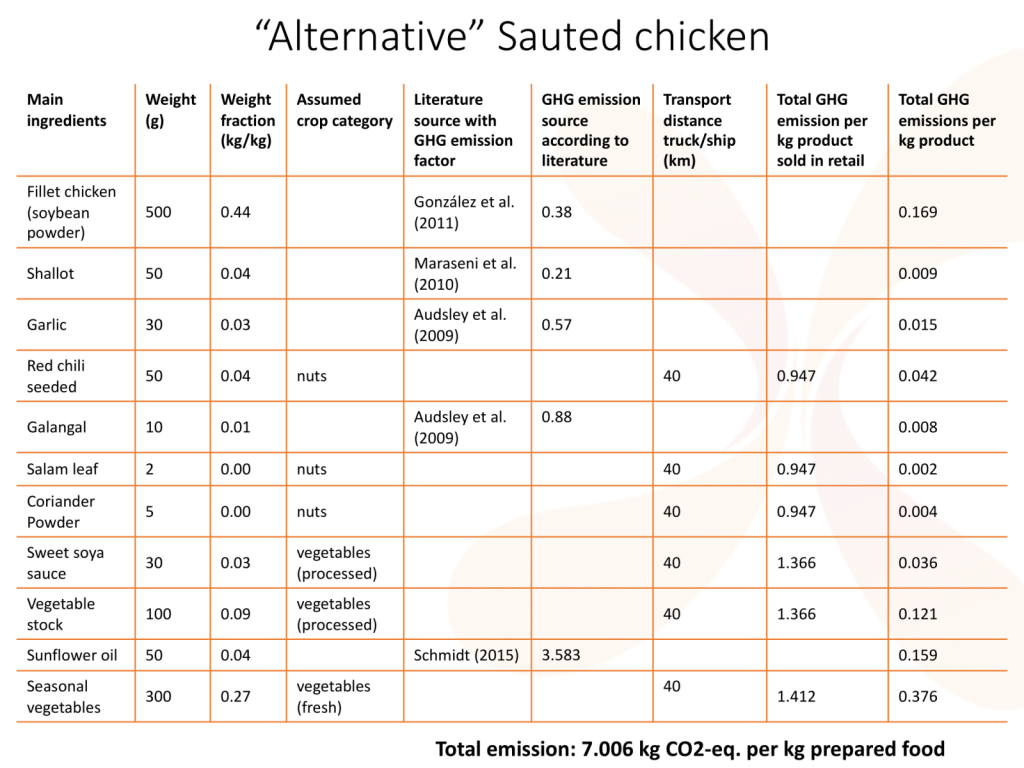
Calculations were done by Norah Titiya Machinjiri, CLIFF-GRADS fellow.

Comparison of emissions from the lunch options
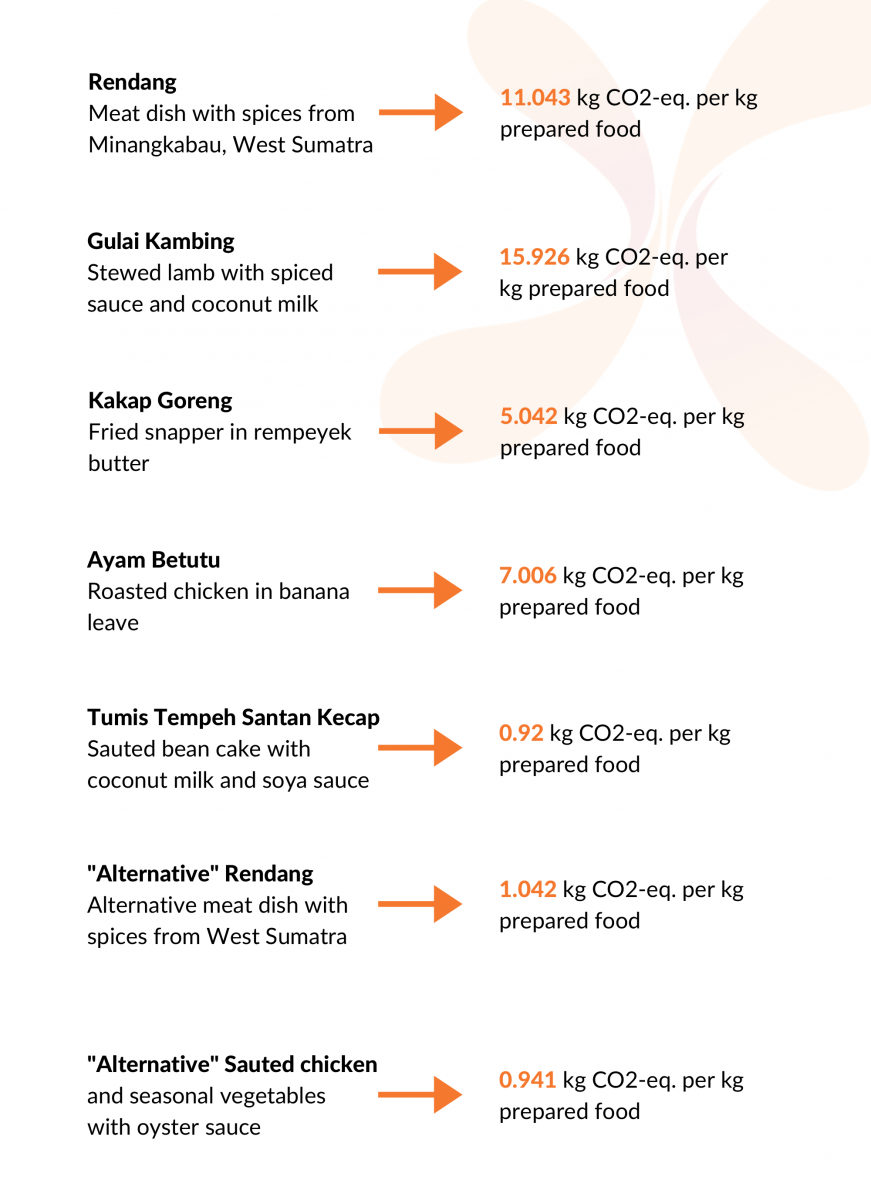
Presentation by Jan Broeze: Conclusions on food waste and associated GHG emissions at the 5th Global CSA Conference
Cover photo: Rendang. Credit: Asian supper